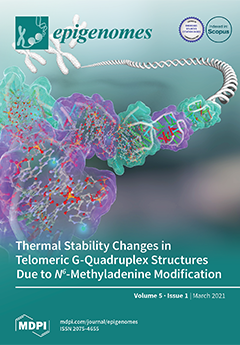N6-methyladenine modification (m
6dA) has recently been identified in eukaryote genomic DNA. The methylation destabilizes the duplex structure when the adenine forms a Watson–Crick base pair, whereas the methylation on a terminal unpaired adenine stabilizes the duplex structure by increasing
[...] Read more.
N6-methyladenine modification (m
6dA) has recently been identified in eukaryote genomic DNA. The methylation destabilizes the duplex structure when the adenine forms a Watson–Crick base pair, whereas the methylation on a terminal unpaired adenine stabilizes the duplex structure by increasing the stacking interaction. In this study, the effects of m
6dA modification on the thermal stability of four distinct telomeric G-quadruplex (G4) structures were investigated. The m
6dA-modified telomeric oligonucleotide d[AGGG(TTAGGG)
3] that forms a basket-type G4 in Na
+, d[(TTAGGG)
4TT] that forms a hybrid-type G4 in K
+ (Form-2), d[AAAGGG(TTAGGG)
3AA] that forms a hybrid-type G4 in K
+ (Form-1), and d[GGG(TTAGGG)
3T] that forms a basket-type G4 with two G-tetrads in K
+ (Form-3) were analyzed. Circular dichroism melting analysis demonstrated that (1) A7- and A19-methylation destabilized the basket-type G4 structure that formed in Na
+, whereas A13-methylation stabilized the structure; (2) A15-methylation stabilized the Form-2 G4 structure; (3) A15- and A21-methylations stabilized the Form-1 G4 structure; and (4) A12-methylation stabilized the Form-3 G4 structure. These results suggest that m
6dA modifications may affect the thermal stability of human telomeric G4 structures in regulating the biological functions.
Full article






